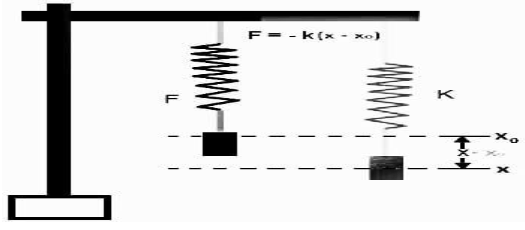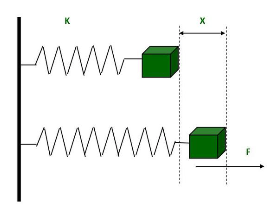Spring Force Formula
- The Spring Force Formula is expressed through the equation: F=-KX
- When a metal spring is stretched or compressed, it is displaced from its equilibrium position. As a result, it experiences a restoring Force that tends to retract the spring back to its original position. The force is called the Spring Force. It is a contact Force that can be found in elastic materials.
- Spring is a tool used daily by many of us
- The spring force formula is given by:
F = K(x – xo)
Where the spring force is F,
The equilibrium position is xo
The displacement of the spring from its position at equilibrium is x,
The spring constant is K
The negative sign tells that the visualized spring force is a restoring force and acts in the opposite direction.

Examples of Spring Force:
Here are a few examples of the spring force from everyday life.
- Pendulum
- Rubber band
- Bungee cord
- Keys in a pc keyboard
- Trampoline
- Shock absorbers
- Watches and toys
- Pogo stick
- Spring balance
The Concept of Spring Force:
For the springs, there is a position at which they are at rest. But when they are either stretched or compressed, then there is A restoring force that will always point in the direction of the equilibrium position. Pendulums are stable during straight down hanging. If a pendulum is pulled away from their equilibrium position, then it swings back and forth as it is acted on by tension force and gravity.
Spring is a tool used usually and their inertia are frequently neglected due to negligible mass. It’s an extremely casual activity that springs, when strained, will undergo the displacement. When it is compacted, it gets compressed. It comes to an equilibrium position. Thus spring exerts an equal as well as an opposite force on a body that compresses or stretches it.
- Imagine one end of a spring is attached to a hook and the other is attached to an object with mass m and allowed to hang down vertically.
- In this case, the object will have two forces.
- One force will be the restoring force of the spring directed upward.
- The other force will be the force of gravity acting on the mass, directed downward.
- If the mass is not moving, it will hang at rest at an equilibrium position where the net force is zero.
The formula for Spring Force:
Simple harmonic motion comes under periodic motion. In SHM, the restoring force F is directly proportional to the displacement X
This restoring force and the displacement always have opposite signs.
A constant of proportionality, K makes it possible to form the equation for the force
i.e, F=-KX
For springs, this relationship is Hooke’s Law, where K will be the spring constant. The SI unit of K is Newton per metre.
In another form,
F=K(x-xo)
Where,
X – the displacement of the spring from its equilibrium position
K – the spring constant
F – Spring force
xo – Equilibrium position
 Profile
Profile Settings
Settings Refer your friends
Refer your friends Sign out
Sign out





